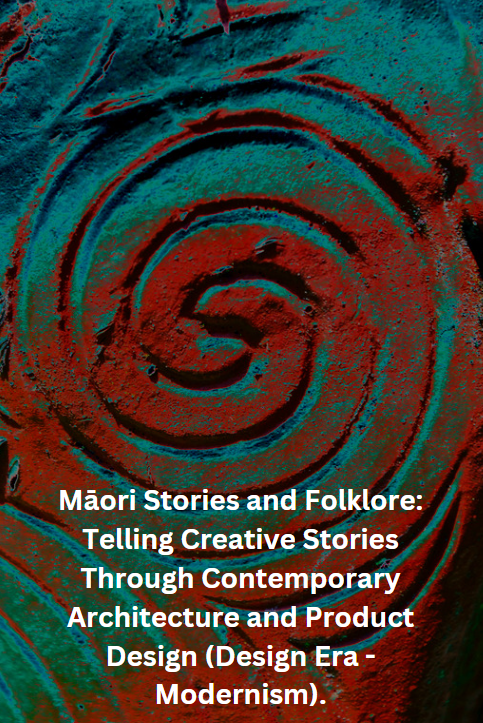

By William Van Zyl (Published 11 February 2024)
This article touches on two Māori stories (folklore). I use the deeper meaning and message to consider a modern building (architecture) or chair (product design). The article is designed to provide an example of how Māori stories and culture could be embedded into contemporary design with a specific focus on architecture and product design (chair design). The new Design and Visual Communication curriculum of New Zealand asks to embed some Māori-inspired shapes, forms, patterns, colours, textures, and more into artwork and design work. This resource uses two stories, Pania of the Reef and Whaitere – The Enchanted Stingray, to show how these stories could convey a message in design work. Some Māori legends (stories) are included as additional examples. I also include some AI-inspired design work at the end based on the two main Māori stories.
Are you a Technology, Cuisine, Woodwork, Metalwork, Art, Architecture, or maybe Industrial Design student? Why not include your culture – your country’s – iconic stories and folklore in your design work? Think like a designer, think like a storyteller, and think about embedding a story into your designs. Also, consider a name for your design – the name will have a lasting impact on your work. Why not produce a contemporary design embedding traditional stories in a new and exciting way? It all starts with brainstorming and collaboration. Find ideas, discuss them in groups, and create quick sketches and diagrams. Then, revisit them and make further changes. Sleep over your initial design. The next day, add some more ideas. Tweak, delete, add, or keep the original idea. Ask your friends, family, teachers, and others what they think. Jot it down. You will be surprised to hear what others see and think. Embed their ideas into your work.
Table of Contents
Before we focus on 2 x specific Māori stories, here are 3 stories (legends) you could consider in a sustainable architectural context:
Māori culture is rich with stories and folklore, many of which are deeply rooted in their spiritual beliefs and connection to the land. Here are a three very simple examples (please search for more Māori stories):
- The Legend of Maui and the Fish
- Summary: Maui is a prominent figure in Māori mythology, known for his many exploits and adventures. One of the most famous stories involves Maui and his brothers going fishing. Maui uses his magical hook to pull up a giant fish, which becomes the North Island of New Zealand. This story highlights themes of creation, the power of gods, and the interconnectedness of people and the land.
- Sustainable architectural design application: This story emphasizes the importance of sustainability and the relationship between humans and nature. Architects could draw inspiration from the idea of respecting and working in harmony with the environment when designing buildings and structures.

Credit: https://www.storytimemagazine.com/downloads/ST_20%20sample%20MAUI.pdf
- The Legend of Hinemoa and Tutanekai
- Summary: This is a romantic legend about Hinemoa, a beautiful Māori maiden, who falls in love with Tutanekai, a chief’s son from a rival tribe. Despite their families’ disapproval, Hinemoa swims across Lake Rotorua to be with Tutanekai. The story celebrates love, perseverance, and overcoming obstacles.
- Sustainable architectural design application: The story’s theme of connection and overcoming barriers could inspire architectural designs that foster community and inclusivity. Sustainable housing projects that prioritize accessibility, community spaces, and integration with the natural environment could be examples of this application.

The love story of Hinemoa and Tutanekai. Credit: Artselemental.
- The Legend of Tāne Mahuta
- Summary: Tāne Mahuta is the god of forests and birds in Māori mythology. According to legend, he separated his parents, the earth mother Papatūānuku and the sky father Ranginui, to create space and light for all living creatures. Tāne is revered as the guardian of the forest and the creatures within it.
- Sustainable architectural design application: This story emphasizes the importance of preserving and respecting natural environments. Architects and designers could draw inspiration from Tāne Mahuta’s role as a guardian of the forest when creating sustainable buildings that prioritize green spaces, use environmentally-friendly materials, and integrate with natural landscapes.

Credit: The Te Reo Maori Classroom.
- The challenge is to identify shapes, forms, patterns, textures, colours and more to convey your message in your building (or product e.g. chair design). Or, embed Māori symbolism into your design. Include these in your building or product design. Include annotations (explain) the subtle embedding in your design and explain your thinking.
These stories provide valuable cultural insights and themes that can inform sustainable architectural design by promoting harmony with nature, community integration, and respect for cultural heritage.
Here are some more Māori stories, legends, and folklore:
IMPORTANT: You have to explore how you could include (embed) these into your architectural or product design.
- The Creation Myth (Te Kore)
- Summary: This myth describes the creation of the world by Io Matua Te Kore, the Supreme Being, from darkness and chaos into the tangible world we know today. It involves the separation of Earth (Papatūānuku) and Sky (Ranginui) and the subsequent birth of various gods and natural elements.
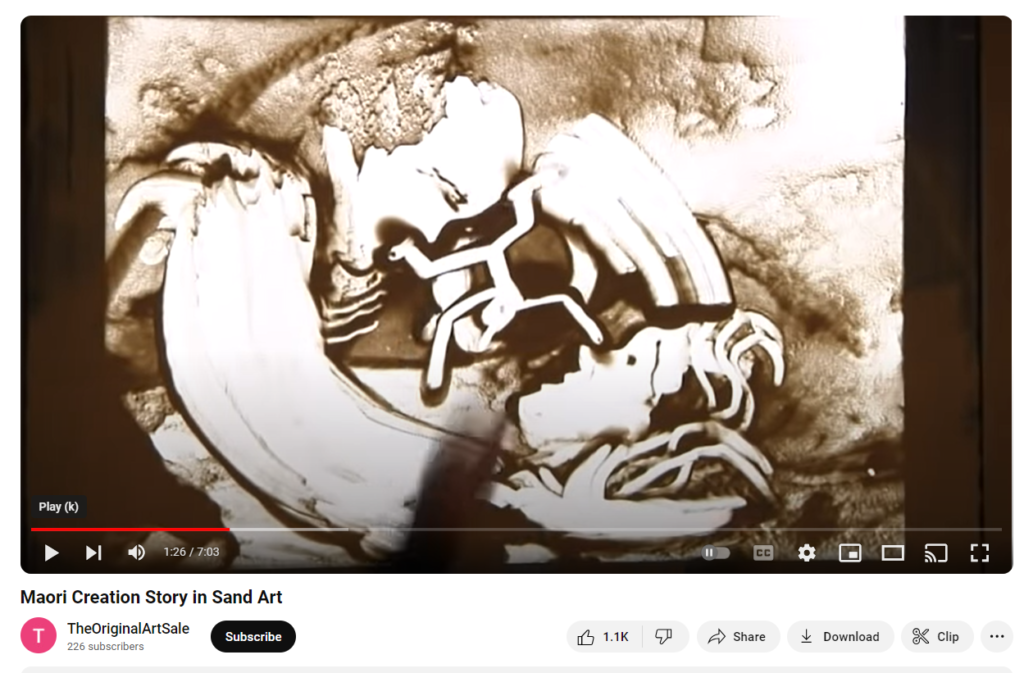
The Maori creation story in sand art – Youtube. Link: https://youtu.be/TDzz_eDq3LE?feature=shared
- The Legend of Rangi and Papa
- Summary: Rangi and Papa are the Sky Father and Earth Mother in Maori mythology. They were once locked in a tight embrace, preventing light from reaching the Earth. Their children, including Tāne Mahuta, decided to separate them, creating space and allowing life to flourish.

- The Legend of Hine-nui-te-pō
- Summary: Hine-nui-te-pō is the goddess of death in Māori mythology. She resides in the underworld and is responsible for guiding souls into the afterlife. The story often involves her encounter with Maui, who sought to defeat death.
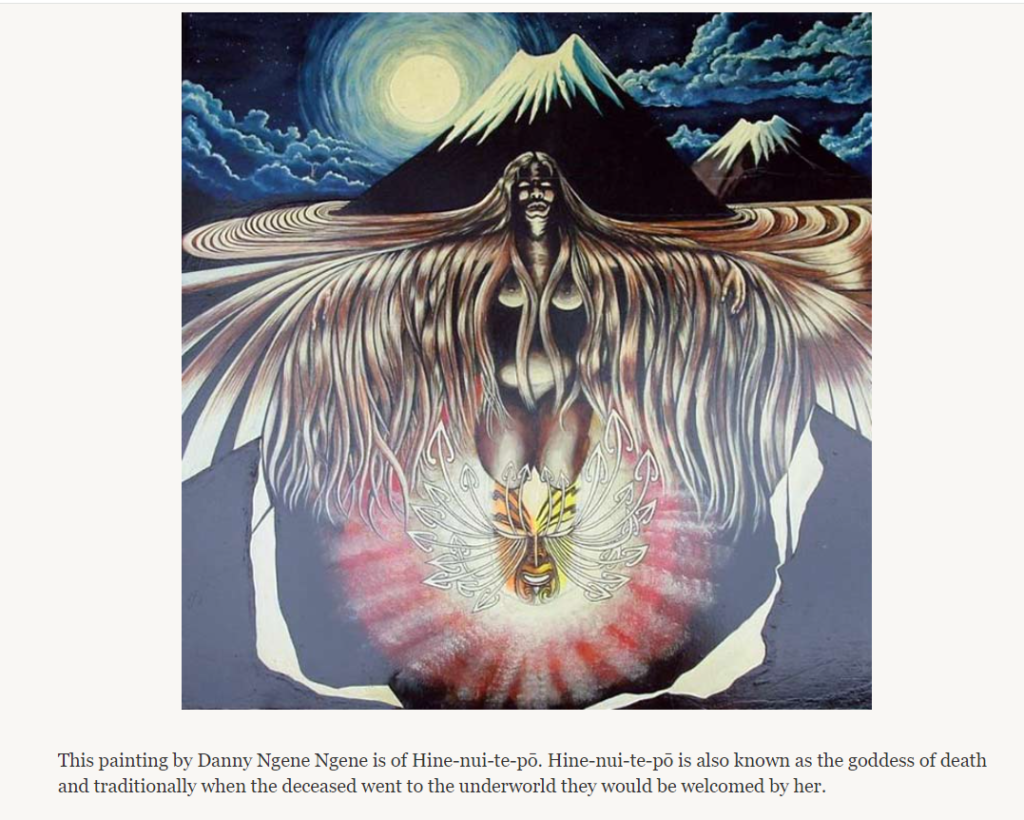
Credit: https://teara.govt.nz/en/artwork/28776/hine-nui-te-po
- The Legend of Whakatane and his wife Rangiuru
- Summary: This legend tells the story of Whakatane, a demigod, who sought to rescue his wife Rangiuru from the underworld. He travels through various challenges and obstacles to reunite with her, demonstrating themes of love, courage, and perseverance.
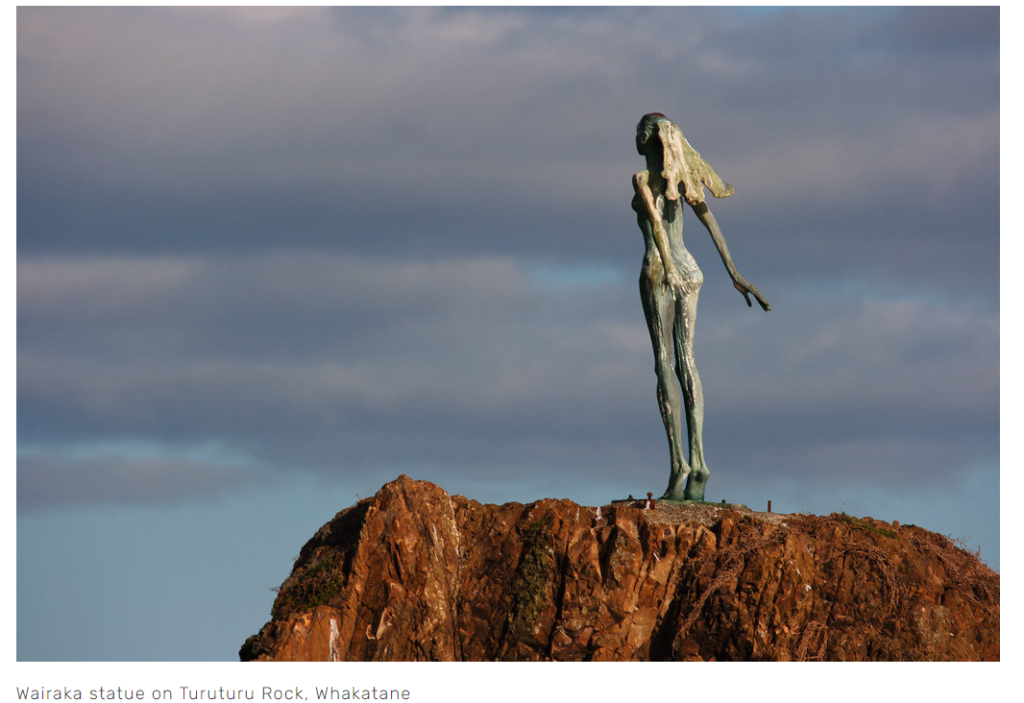
Credit: https://honourthemaunga.org.nz/wairaka-history
- The Legend of Tāwhaki
- Summary: Tāwhaki is a legendary hero in Māori mythology, known for his incredible feats and adventures. He embarks on a quest to avenge the death of his father and faces numerous challenges along the way, showcasing bravery and determination.

This near-death experience revealed Tawhaki’s status as a demigod, and from this point Tawhaki continued to use his powers and gifts to help those around him in ways no human could. Credit: https://www.whitcoulls.co.nz/ko-tawhaki-nui-a-hema-ana-mahi-whakah-6709012
- The Legend of Hine-korako
- Summary: Hine-korako is a mythical figure associated with the creation of geothermal features in New Zealand, such as geysers and hot springs. The legend often involves her journey to find her husband, who is trapped in the underworld, and her tears creating the geothermal landscape.
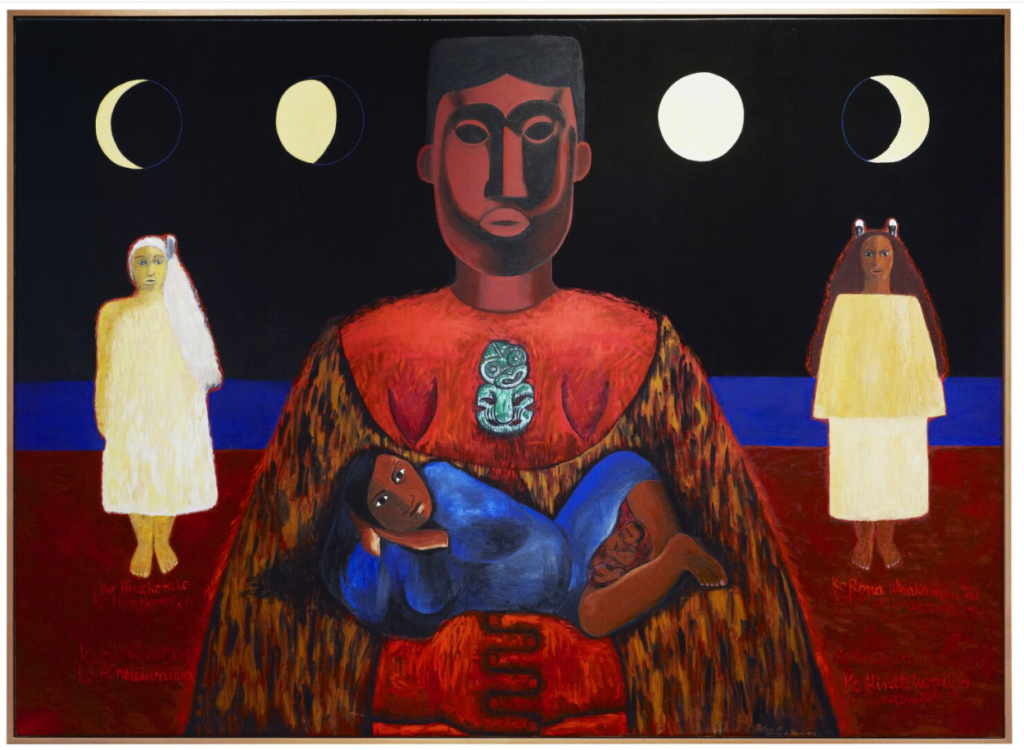
This painting by Robyn Kahukiwa focuses on the mana (prestige) of Māori women and, more particularly, of female ancestors who feature in Māori creation stories. Credit: https://collections.tepapa.govt.nz/object/172115
- The Legend of Taniwha
- Summary: Taniwha are mythical creatures in Maori folklore, often depicted as powerful guardians of waterways or natural features. They can be benevolent or malevolent, and stories about them serve as cautionary tales or explanations for natural phenomena.

Credit: https://dorothybutler.co.nz/p/maori-myths-legends-tamure-and-the-taniwha
- The Legend of Kupe
- Summary: Kupe is a legendary figure in Māori history and folklore, credited with discovering New Zealand. His adventures, including encounters with mythical creatures and exploration of the seas, are celebrated in various stories and traditions.
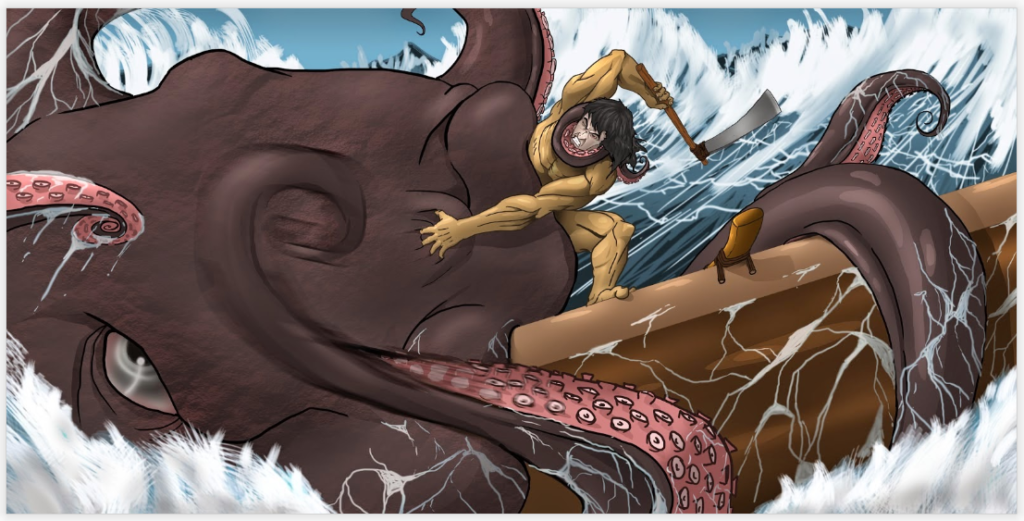
Credit: https://fromnewzealandtotheworld.blogspot.com/2014/11/myths-and-legends-from-new-zealand_8.html
These stories, legends, and folklore are integral to Māori culture and provide insight into their spiritual beliefs, values, and worldview. They offer a rich tapestry of narratives that continue to influence and inspire contemporary Māori society.

A Summary of the Story: PANIA OF THE REEF – Including a Modern context:
“Pania of the Reef” tells the tale of a beautiful maiden, Pania, who is the daughter of Tangaroa, the sea god. She falls in love with a human man named Karitoki and often visits the shore to be with him despite her father’s warnings. Ultimately, Tangaroa commands Pania to return to the ocean’s depths, leaving her heartbroken but vowing to remain connected to the land and its people forever.
This story embodies several essential themes, including guardianship of the ocean and sustainability. Pania’s connection to the sea highlights the Māori’s deep respect and reverence for the ocean and its creatures. It emphasises the importance of preserving marine ecosystems and maintaining a harmonious relationship with the natural world.
In a modern context, the story of Pania of the Reef reminds us of our responsibility to protect and conserve the ocean for future generations. It inspires practices and policies that promote sustainability, such as reducing pollution, mitigating climate change, and supporting marine conservation efforts. By honouring Pania’s legacy and embracing our role as stewards of the ocean, we can ensure a healthier and more sustainable planet for all beings.

IMAGE: Pania of the Reef (Napier – New Zealand). Credit Tripadvisor. Link: https://www.tripadvisor.co.nz/Attraction_Review-g255109-d10084542-Reviews-or10-Pania_of_the_Reef_Statue-Napier_Hawke_s_Bay_Region_North_Island.html
Embedded Design Concept: PANIA OF THE REEF
Inspired by the tale of Pania of the Reef, an architectural design could seamlessly integrate elements of the ocean, beauty, and the connection between land and sea.
- Fluid Lines and Curves: The exterior of the building could be designed with fluid lines and curves reminiscent of ocean waves, mirroring the graceful movements of Pania in the water. These curves can be incorporated into the structure’s facade, creating a sense of movement and fluidity.
- Reflective Surfaces: Just as the sea reflects the sky and surrounding environment, the building’s surfaces could feature reflective materials such as glass or polished metal. This would capture the ocean’s essence and create an ever-changing interplay of light and shadow throughout the day.
- Integration of Water Features: Water plays a significant role in Pania’s story, symbolising her origin and connection to the land. Incorporating water features such as ponds, streams, or even a small indoor waterfall into the design would pay homage to this element. These features also serve as focal points for relaxation and contemplation, inviting occupants to connect with nature.
- Organic Materials and Textures: To evoke the natural beauty of the ocean and the land, the interior design could feature organic materials such as wood, stone, and earth-toned fabrics. Textures inspired by shells, sand, and coral could be incorporated into furnishings and decor, creating a tactile connection to the story’s setting.
- Seamless Indoor-Outdoor Transition: Just as Pania bridged the divide between land and sea, the architectural design should facilitate a seamless transition between indoor and outdoor spaces. Large windows, sliding glass doors, and outdoor terraces or patios would blur the boundaries between the interior of the building and its natural surroundings, allowing occupants to feel connected to the environment.
Summary:
By incorporating these elements into the architectural design, the Pania of the Reef story can be brought to life in a modern context, creating a space that celebrates the beauty of nature, the richness of Māori culture, and the enduring connection between land and sea.
AI-inspired building (Discord/Midjourney): PANIA OF THE REEF
Prompt: “Inspired by the tale of Pania of the Reef, Māori folklore in New Zealand, create a building that reflects the symbolism of ‘Pania of the Reef.’ The architectural design should seamlessly integrate elements of the ocean, the beauty of nature, the connection between land and sea, and Māori culture.”

IMAGE: Can you identify the many sea-inspired shapes forms, patterns and textures in these building designs? Can you identify a hidden story?



Whaitere – The Enchanted Stingray:
‘Whaitere, The Enchanted Stingray’ is a Māori tale of a powerful and mystical stingray named Whaitere. Whaitere possessed magical abilities and was revered by the people of the ocean for her wisdom and protection. She was known to guide fishermen to abundant fishing grounds and warn them of impending dangers.
However, Whaitere’s powers also attracted the attention of a greedy chief who sought to harness her magic for his own gain. In his pursuit, the chief captured Whaitere and attempted to control her, but the stingray’s spirit could not be tamed. With a fierce surge of energy, Whaitere broke free from captivity, leaving the chief humbled and repentant.
From that day forth, Whaitere continued to roam the ocean, serving as a guardian (kaitiaki) and protector of its creatures. Her story serves as a reminder of the importance of respecting the natural world and living in harmony with its inhabitants.
In modern times, the legend of Whaitere can inspire us to embrace guardianship over the ocean and prioritise sustainability in our interactions with marine ecosystems. By preserving and protecting the ocean and its inhabitants, we honour the legacy of Whaitere and ensure a healthy and vibrant environment for future generations.
Here is an excerpt:
Whaitere floated to the surface looking down at the mayhem below her.
“Stop!” she said, “We need to teach the people fish that we have as much right to this place as they!”
As Whaitere was speaking a huge shadow raced towards her. The assembly of sea creatures were spellbound as Whaitere dove under the shadow, and turned onto her back. Her skin pulsed with magic as she flapped her wings and a massive surge of water hurtled towards the dark shape. The shadow wobbled and shuddered then a people fish toppled into the sea. Other shadows headed towards them, but soon succumbed to the same fate.
The people fish swam to shore, all except one who sank to the bottom of sea. Whaitere and the others watched as his lungs filled with water, his eyes enlarged with a blank stare and his arms stretched out.
“Teach them to respect your home.”
Whaitere could hear the words of her parents echoing in her mind.
Whaitere looked into the eyes of the people fish, then spoke to him in a language he could understand.
“Go back to your people and teach them to respect this place. Our bay will be an example for all your kind and a safe place for ours.”
With that, Whaitere lifted the people fish onto her back and returned him to shore.
*Credit:TKI NZ (Matauranga Māori).
Read the full story here: https://eng.mataurangaMāori.tki.org.nz/Support-materials/Te-Reo-Māori/Māori-Myths-Legends-and-Contemporary-Stories/Whaitere-the-enchanted-stingray
Simple ideas for how we can use the story of “Whaitere – The Enchanted Stingray” to help take care of our oceans and make buildings that don’t harm the environment:
- Ocean School: We can make a special school all about the ocean, inspired by Whaitere’s story. This school could teach people about the creatures in the sea, how to fish responsibly, and why it’s important to keep the oceans clean.
- Green Lab by the Sea: We could build a lab near the ocean where scientists study sea animals and plants. We’d use materials that don’t hurt the environment, and we’d try to save energy in how we design the lab. Scientists could learn how climate change affects the ocean and how we can help protect it.
- Nature-Friendly Beach House: Imagine a cozy house near the beach that’s good for the environment, just like Whaitere. It would have solar panels for power, use recycled materials, and have a garden with plants that help the local ecosystem. People could stay there and enjoy nature without harming it.
- Underwater Safe Haven: We could create a special place underwater where sea creatures are safe, like a sanctuary. It would have things like fake reefs and sculptures, and signs to teach visitors about protecting the ocean. People could go there to learn and appreciate the ocean without disturbing it.
- Eco-Village by the Shore: Picture a whole community living near the sea in a way that’s friendly to nature, inspired by Whaitere. The houses would be built to save energy, there would be solar panels and gardens, and everyone would work together to keep the ocean clean and healthy.
- Patrolling the ocean: Marine police managing the precious sea life in our oceans. Identifying and calling out those that abuse the resources.
- Educating children and adults: Focus of sustainability and the responsibility of all to look after our oceans. For example, eliminating plastic flowing into the ocean.
- Can you think of more applications?
By using Whaitere’s story to guide us, we can make sure our buildings and communities are good for the environment, just like she protects the ocean and its creatures.
PROMPT (AI): TITLE: Whaitere – the enchanted stingray (contemporary Māori folklore). Inspired by the tale of ‘The enchanted Stingray’, create a building that reflects the symbolism of ‘a Stingray’ The architectural design should seamlessly integrate elements of the ocean, the stingray shape and form, the connection between the availability of seafood and looking after the sea, managing the sustainability of the ocean (fishing), and Māori culture.

IMAGE 1: Can you see the flowing ocean-related shape, form, and pattern? What shell or shellfish do you see?

IMAGE 2: Look at the roof covering. See the patterns? I see Hundertwasser’s patterns on the roof (ceramic tiles).
The Hundertwasser Art Museum in Whangarei (New Zealand):

VIDEO: Structure covered in ceramics (pieces of broken ([or whole] tiles cover large surfaces of the building). The ebb and flow of nature is embedded in the building. Nothing is straight and flat. Even the floors are not flat – they are wavey. How could you include this concept – the flowing lines of nature – into your design work? Architecturally speaking: How could you use these shapes, forms, patterns, colours and more for A beach house, a museum, a seating area, or a pavillion? Link to video: https://youtu.be/TfxS7kreNLw?feature=shared
Here is an example of another creative design – A Tea Pavilion:
This example does not relate to the Stingray-concept or the Hundertwasser Museum. It is just an additional idea I include as inspiration. See the unique bamboo texture.

IMAGE: Organic inspiration: Nestled within a tea estate, this pavilion offers a unique culinary experience amidst the lush plantation. Crafted primarily from bamboo, the structure showcases the material’s versatility through intricate design and detailing. Despite its seemingly modest size, the pavilion cleverly immerses visitors within, revealing frequent, captivating views of the surrounding vegetation. Credit: Mianzi & QX Design. What will you design? Link to article: https://themeritlist.com/2023/08/15/makaibari-tea-pavillion/

IMAGE 3: PROMPT (AI-generated image): TITLE: ‘Whaitere – the Enchanted Stingray’ (based on contemporary Māori folklore).

IMAGE 4: PROMPT (AI-generated) – TITLE: Whaitere – the enchanted stingray (contemporary Māori folklore). See the textures and patterns. You can use SketchUp Pro to include textures and patterns to your design work. Watch some videos on how to.
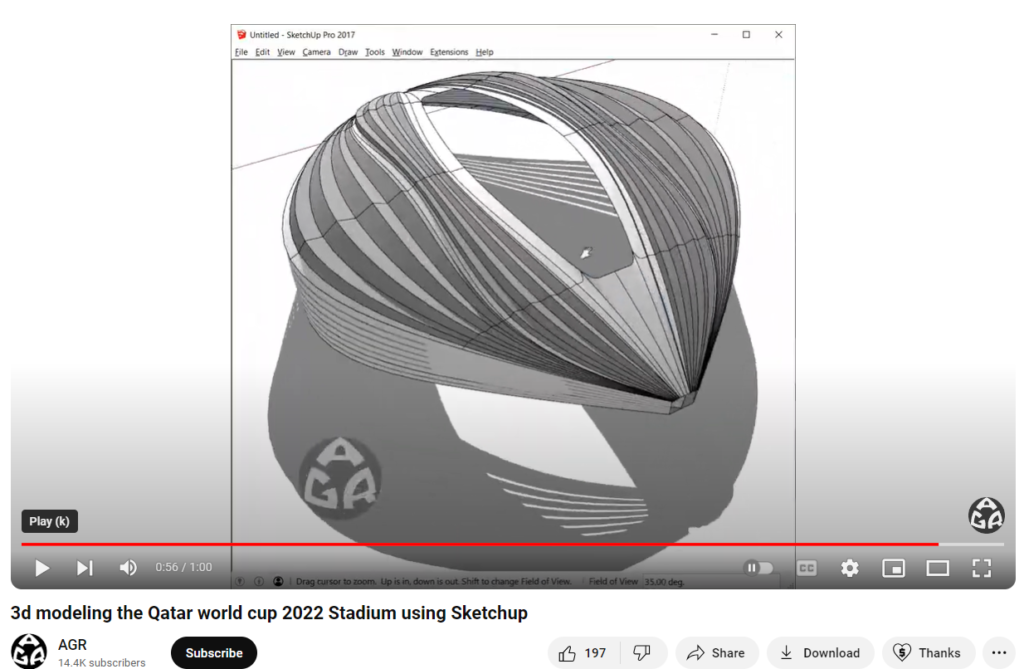
Link to video – Qatar World Cup Stadium 2022 (creating organic shapes in SketchUp): https://youtu.be/RGdw43SMf_s?feature=shared

IMAGE: AI-Generated. PROMPT: Stingray-inspired house. Modern style. Can you identify the stingray shape & form?

IMAGE: Stingray-inspired house. There are two species of stingray commonly found in New Zealand waters, these being the long-tailed stingray Dasyatis thetidis and the short-tailed stingray Dasyatis brevicaudata. The easiest way to differentiate between these species is by the length of the tail.
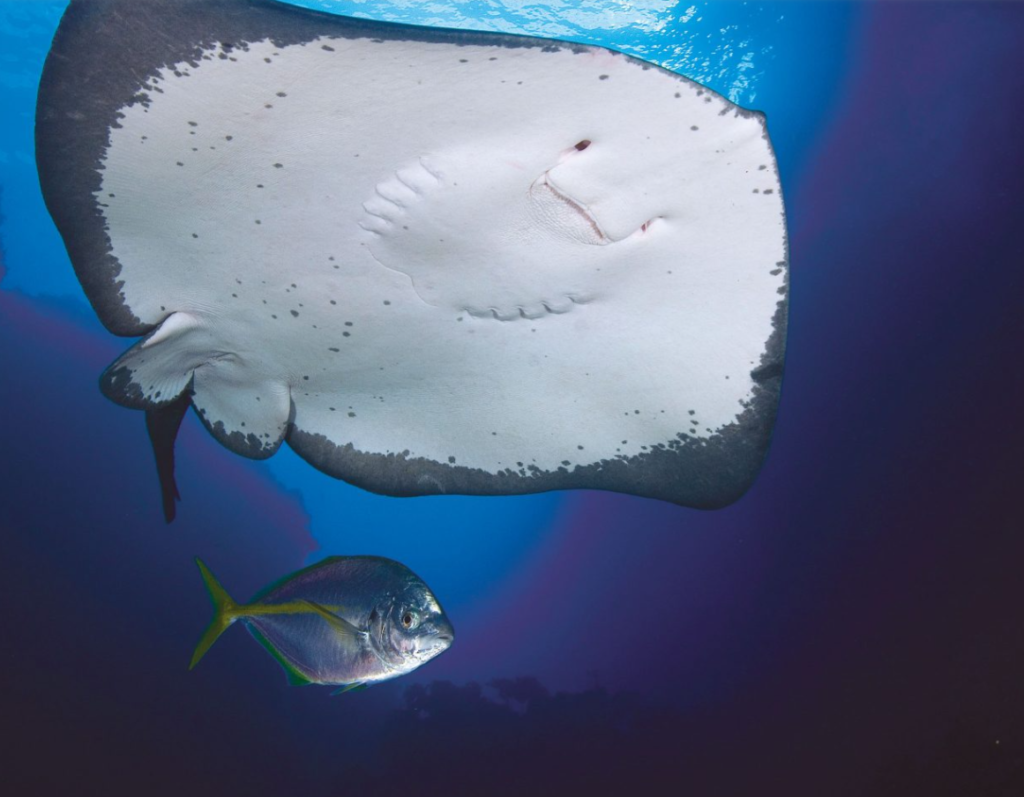
IMAGE: NZ Stingray. There are 3 common stingrays in NZ: The long-tail, short-tail and eagle stingray. Credit: National Geographic. https://www.nzgeo.com/stories/stingrays/
Can you think of more Māori concepts and ideas – inspired by Māori stories and folklore – that could be embedded into architectural and product design?
Māori-inspired chair design: Based on the contemporary story of ‘Whaitere – The Enchanted Stingray’
AI-prompt (Midjourney): ‘Whaitere – The Enchanted Stingray’ (contemporary Māori folklore): Inspired by the tale of ‘The Enchanted Stingray’, create a chair that reflects the symbolism of ‘a Stingray’ The product design should seamlessly integrate elements of the ocean, the stingray shape and form, the connection between the availability of seafood and looking after the sea, managing the sustainability of the ocean (fishing), and Māori culture.

Could this chair be carved out of wood? Could it be 3D printed? IMPORTANT: Note that it could be inappropriate to have Māori patterns on the seat. Māori Tikanga. Best not to include any Māori shape, form, or pattern on the seating area (acknowledging Maori protocols).

What materials could be used for this chair? Could you change the colours? IMPORTANT: Note that it could be inappropriate to have Māori patterns on the seat. Māori Tikanga. Best not to include any Māori shape, form, or pattern on the seating area (acknowledging Maori protocols).

What padding (cushioning) could you use for your chair? To make it comfortable – considering anthropometrics and ergonomics – what could you change or consider?

The seat is a bit spikey. Could the protrusions damage clothing? How could you make small – or big changes to this chair? IMPORTANT: Note that it could be inappropriate to have Māori patterns on the seat. Māori Tikanga. Best not to include any Māori shape, form, or pattern on the seating area (acknowledging Maori protocols).
Let’s have a quick look at a different design era: Bauhaus and Māori (combined)
A List of Bauhaus Features:
- 1. Geometric Shapes: Bauhaus chairs often feature clean lines and geometric shapes such as squares, rectangles, and circles, reflecting the movement’s emphasis on simplicity and functionality.
- 2. Minimalist Design: Bauhaus chairs prioritise minimalist design principles, stripping away unnecessary ornamentation and focusing on essential elements to achieve a sleek and uncluttered aesthetic.
- Tubular Steel Frames: Many Bauhaus chairs utilise tubular steel frames for their structural support, offering strength and durability while also embracing industrial materials and construction methods.
- Functionality: Functionality is a key aspect of Bauhaus design, and chairs are no exception. Bauhaus chairs are designed to be comfortable and ergonomic while also fulfilling their intended purpose efficiently.
- Modularity: Bauhaus chairs often feature modular components that can be easily assembled, disassembled, or rearranged, allowing flexibility and adaptability in various settings and spaces.
- Primary Colors: Bauhaus chairs frequently incorporate primary colours such as red, blue, and yellow, painted surfaces or upholstered cushions, adding visual interest and contrast to the design.
- Form Follows Function: This Bauhaus principle emphasises that the shape and design of an object should be determined by its intended function. Bauhaus chairs embody this concept by prioritising practicality and usability in their design.
- Industrial Materials: Bauhaus chairs embrace industrial materials such as steel, aluminium, and plywood, reflecting the movement’s embrace of modern manufacturing processes and mass production techniques.
- Flat Surfaces: Bauhaus chairs often feature flat surfaces and planes, creating a sense of simplicity and orderliness in the design while facilitating ease of manufacture and assembly.
- Streamlined Silhouettes: Bauhaus chairs typically have streamlined silhouettes, free from unnecessary embellishments or decorative elements, resulting in a visually cohesive and harmonious design.
By incorporating these Bauhaus features into chair design, one can create a piece embodying the movement’s simplicity, functionality, and modernity principles.
AI-PROMT: Create a contemporary Bauhaus-style chair with some Māori shapes and forms embedded in it. Combine Bauhaus and Māori-inspired shapes, forms, and patterns. Focus on Bauhaus colours. See chair designs below.

IMAGE: Material? Vinyl or coloured leather?

IMAGE: The Bauhaus features are apparent in the chair design. However, can you identify any Māori-inspired details in the chair design? Look for contemporary Māori shapes and forms. Also, look for Māori colours. See the chrome tubed legs – typical Bauhaus.

IMAGE: Can you identify any Māori Patterns or iconic shapes and forms anywhere? IMPORTANT: Note that it could be inappropriate to have typical traditional Māori patterns on the seat. Māori Tikanga. Best not to include any Māori shape, form, or pattern on the seating area (acknowledging Maori protocols).

IMAGE: Timber frame spray-painted In a black colour? IMPORTANT: Note that it could be inappropriate to have typical traditional Māori patterns on the seat. Māori Tikanga. Best not to include any Māori shape, form, or pattern on the seating area (acknowledging Maori protocols).
Using the words ‘fabric’ in AI-generated images: Different Design Eras and Styles

IMAGE: Prompt – Colorful Art Nouveau Chair With Lights A Luxurious And Primitivist Frenzy

IMAGE: AI – Colorful Paisley Chair A Photorealistic Rendering Of Modern American Art

IMAGE: Colorful Patchwork Armchair. A Pop Art Inspired Piece Of Comfort
It is your turn: Here is your challenge
As a designer or architect, what will you design? Are you a DVC Level 1 student in New Zealand (secondary school)? How will you embed Māori stories and folklore into your design work? Could you tell a story with your designs? Do you have an important message? Do you love writing? Why don’t you write a unique contemporary Māori-inspired story? Why not use your own Māori story (fiction) and embed it into your design work? Create the artwork for your story – why not use AI to assist you with ideas? Make quick sketches with pencil. ink (fountain pen) and watercolours. Search “Urban Sketching” to see how quickly concept sketches can be created.

Urban sketching – quick and loose. Link: https://youtu.be/DdbQLBdhMcY?feature=shared
Citation:
Van Zyl, W.N., 2024. Māori Stories and Folklore: Telling Creative Stories Through Contemporary Architecture and Product Design (Design Era – Modernism). Article published to Five House Publishing. Link: https://fivehousepublishing.com/2024/02/11/maori-stories-and-folklore-telling-creative-stories-through-contemporary-architecture-and-product-design-design-era-modernism/
Copyright © 2024 by William Van Zyl
Māori Stories and Folklore: Telling Creative Stories Through Contemporary Architecture and Product Design (Design Era – Modernism).
All rights reserved. This eBook/article or any portion
thereof may not be reproduced or used in any manner
without the publisher’s permission, except for using brief quotations in a book review.
Published by Five House Publishing (New Zealand)
First Publishing, February 2024

More eBooks and articles are available at https://fivehousepublishing.com/
More about the author at http://williamvanzyl.com/